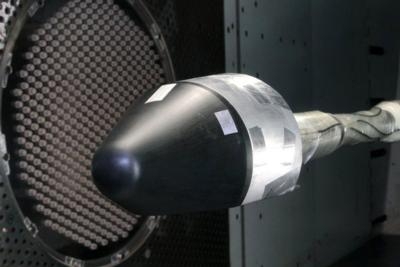Sat, Apr 28, 2012
Wind Tunnel Experiments Validate Aerodynamic Qualities For Re-Entry
Blue Origin, which normally shuns the attention of the media, said Thursday it has successfully tested the design of its next-generation Space Vehicle, completing a series of wind tunnel tests to refine the aerodynamic characteristics of the spacecraft’s unique biconic shape. The tests were carried out as part of Blue Origin’s partnership with NASA under the agency’s Commercial Crew Development (CCDev) program. Blue Origin is designing the Space Vehicle to provide safe, affordable transport of up to seven astronauts to low-Earth orbit and the International Space Station.

“Our Space Vehicle’s innovative biconic shape provides greater cross-range and interior volume than traditional capsules without the weight penalty of winged spacecraft,” stated Rob Meyerson, president and program manager of Blue Origin. “This is just one of the vehicle’s many features that enhance the safety and affordability of human spaceflight, a goal we share with NASA.”
The wind tunnel tests validated Blue Origin’s analysis of the Space Vehicle’s aerodynamics during descent through the atmosphere and the ability to change its flight path, increasing the number of available landing opportunities each day and enhancing the vehicle’s emergency return capability. More than 180 tests were conducted over the past several weeks at Lockheed Martin’s High Speed Wind Tunnel Facility in Dallas.

Under CCDev, Blue Origin is maturing the design of the Space Vehicle, including its aerodynamic characteristics, culminating in a System Requirements Review in May of this year. Blue Origin will conduct tests of its pusher escape system later this year, demonstrating the ability to control the flight path of a subscale crew capsule using an innovative thrust vector control system. Also under CCDev, Blue Origin is conducting tests of the thrust chamber assembly (TCA) for the BE 3 100,000-lbf liquid oxygen, liquid hydrogen rocket engine, which was recently installed on the E 1 complex test stand at NASA’s Stennis Space Center.
Blue Origin is backed financially by Amazon.com founder Jeff Bezos. (Images provided by Blue Origin)
More News
From 2021: The Inside Skinny On What Being An ANN Oshkosh Stringer Is All About By ANN Senior Stringer Extraordinare, Gene Yarbrough The annual gathering at Oshkosh is a right of p>[...]
Video Showed That During The Takeoff, The Nose Baggage Door Was Open On May 10, 2025, about 0935 eastern daylight time, a Piper PA-32RT-300, N30689, was destroyed when it was invol>[...]
Get The Latest in Aviation News NOW on Instagram Are you on Instagram yet? It's been around for a few years, quietly picking up traction mostly thanks to everybody's new obsession >[...]
"I think what is key, we have offered a bonus to air traffic controllers who are eligible to retire. We are going to pay them a 20% bonus on their salary to stay longer. Don't reti>[...]
Aero Linx: Pilot Briefing The gathering, translation, interpretation, and summarization of weather and aeronautical information into a form usable by the pilot or flight supervisor>[...]
 Oshkosh Memories: An Aero-News Stringer Perspective
Oshkosh Memories: An Aero-News Stringer Perspective NTSB Prelim: Piper PA32RT
NTSB Prelim: Piper PA32RT ANN FAQ: Follow Us On Instagram!
ANN FAQ: Follow Us On Instagram! Aero-News: Quote of the Day (05.28.25)
Aero-News: Quote of the Day (05.28.25) ANN's Daily Aero-Term (05.28.25): Pilot Briefing
ANN's Daily Aero-Term (05.28.25): Pilot Briefing




